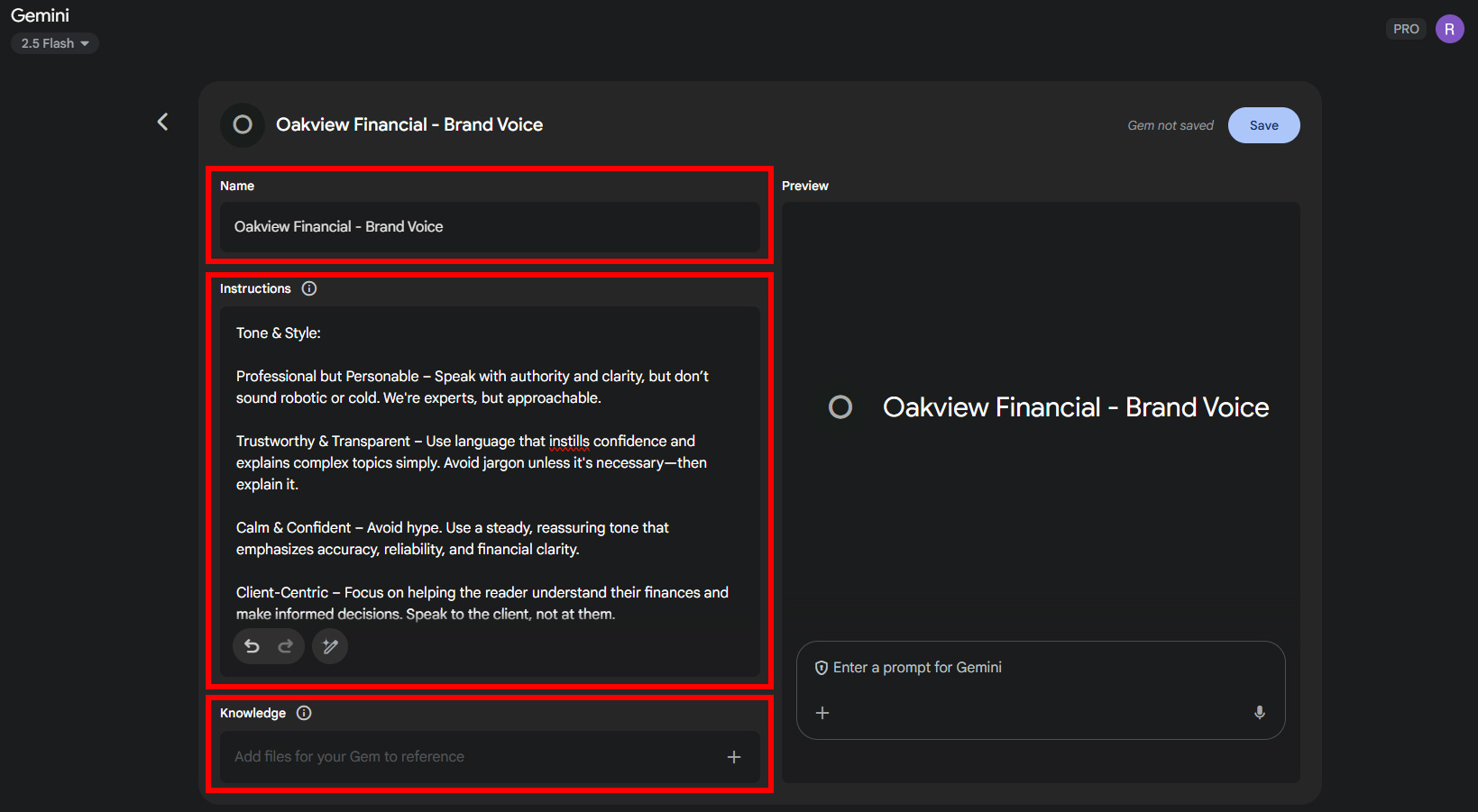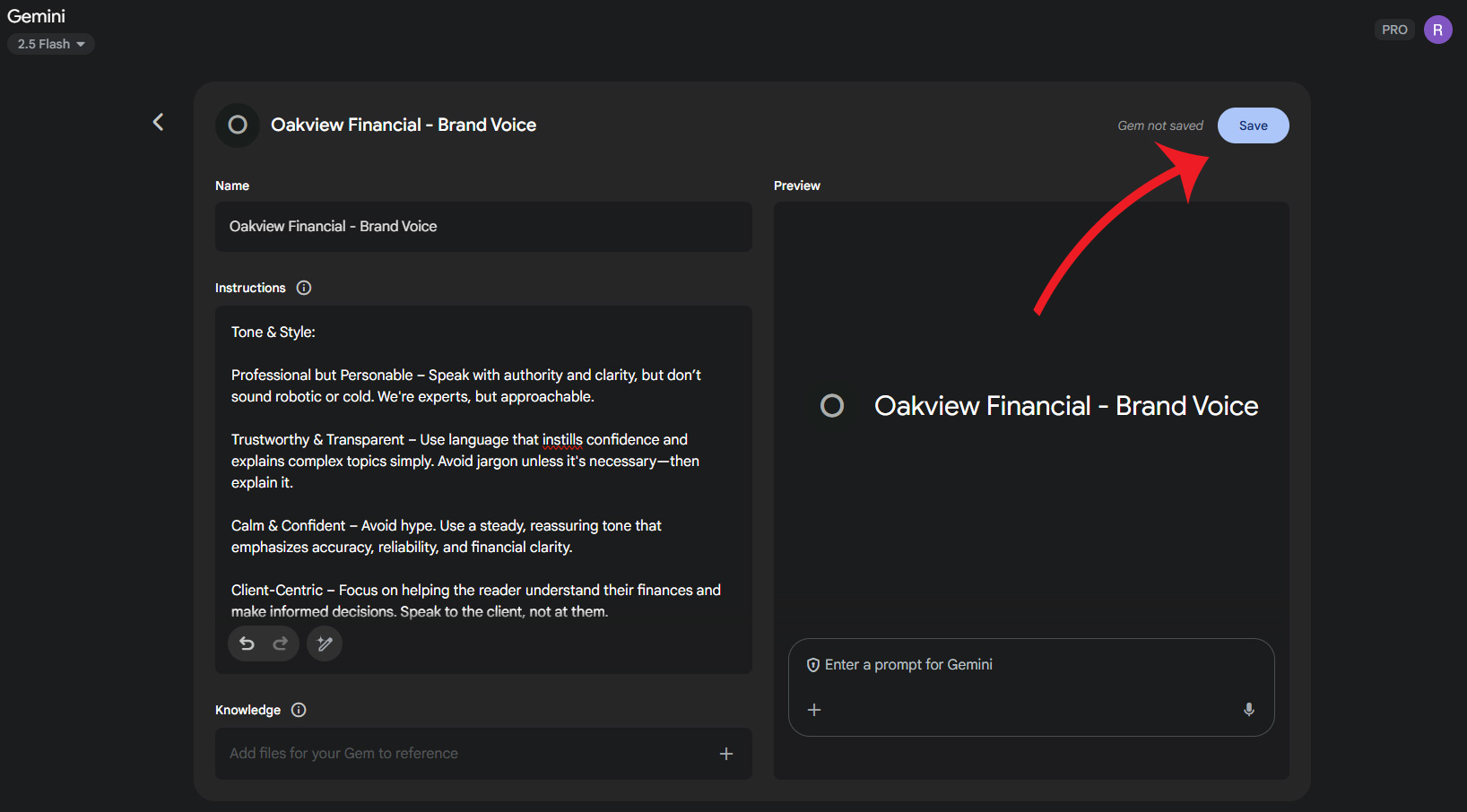How to Train Generative AI to Speak in Your Brand Voice
A practical guide to training AI tools like Gemini to write with your tone, speak in your style, and scale content without losing your identity.
A practical guide to training AI tools like Gemini to write with your tone, speak in your style, and scale content without losing your identity.
Start typing to search...
The conversation around Generative AI is everywhere, and for good reason. It’s reshaping how marketing teams operate each day. Exciting? Absolutely. But many marketers are asking a very real question: Can Generative AI actually capture our brand’s voice? Or will it just spit out generic content that waters down our identity?
The answer is, yes. Capturing your unique brand voice with Generative AI is entirely possible with the right strategy and intention. It’s not about handing over the reins to your AI model, but rather guiding it, training it, and shaping the conversation so every piece of content sounds like you.
In this guide, we’ll walk through actionable strategies to help your Generative AI models deliver consistent, on-tone content that connects with your audience and strengthens your brand identity.
Before you generate a single sentence, one thing must be clear. A Large Language Model (LLM) can't create your unique brand voice from scratch. if you haven't clearly defined it first. The model won’t know what to emulate. Without clear guidance, the model will essentially operate with a very high "temperature" in terms of tone, drawing from its vast training data to return a wide variety of styles. This usually leads to inconsistent outputs that simply won't sound like your brand, making your content feel unrecognizable. Generative AI is incredibly powerful, but its output is only as good as the input and the instructions you provide. For the model to consistently produce content that sounds unmistakably like your brand, you need to hand it a clear, concise blueprint of your brand's voice.
So where do you begin? Start by explicitly pinpointing the core elements of your brand voice. Is it professional and authoritative, or casual and witty? Empathetic and supportive, or direct and no-nonsense? Think about adjectives that best describe your brand's personality, how you want to be perceived, and the emotional connection you aim to build with your audience. Consider your desired vocabulary, sentence structure preferences (short and punchy versus flowing and descriptive), and even your stance on contractions. This detailed definition is crucial because it allows you to effectively use techniques like chain prompting to progressively train your Generative AI model towards your brand's precise tone, ensuring consistency across multi-step content generation, while simultaneously reinforcing what’s incorrect.
This isn't just a style guide for human writers anymore; it’s a living document that will inform your model's prompts and training.
Here’s a template that you can use:
Contextual Prompts: Add examples of how you’d prompt Gemini using this voice. For example:
“Act as our Community Manager. Write a friendly, informative FAQ answer explaining our sustainability policy to a curious customer.”
To truly master on-tone content with Generative AI models, you have to go a step further than just defining your brand's tone. You need to bring in persona-driven prompting. This means assigning a specific role or character to the AI model when you prompt it. Think of it like saying "Pretend you're..." whether that's a subject matter expert, a brand leader, or a helpful team member. This simple shift gives the model clear direction on how to sound and think, aligning its tone and delivery with the way your brand actually communicates.
By setting this kind of context, you’re not just asking the model to write. You’re asking it to take on a perspective. That nuance helps shape more precise, consistent output that fits both your overall brand voice and the specific use case or audience you're speaking to.
Leverage persona-driven prompting by implementing “Act As” instructions that direct the model to adopt specific personas. For example:
Persona-driven prompting is an iterative process. Pay close attention to the model's output when using a specific persona. If it's not quite hitting the mark, refine your persona description within the prompt. You might add more adjectives, specific examples, or clarify what the persona wouldn't say. This continuous refinement helps the model learn and consistently deliver the precise tone you're aiming for.
Everything we’ve covered so far, from tone and style to prompts and examples, can be applied to any major Generative AI platform. These are model-agnostic techniques, which means they’ll work across the most popular models on the market today, like:
Each tool has its own strengths, but the goal is the same. In the next section, we’ll walk through how to set this up in Google Gemini, If you haven’t used Gemini before, you can try it at gemini.google.com. If you’re less familiar with Gemini, it’s Google’s Generative AI platform tool that is also integrated into Google Search, Gmail, Docs. and more of the Google ecosystem.
We chose Gemini for this guide because it offers a feature called Gems—custom assistants that let you save and reuse your brand voice instructions. It’s a great option for teams that want consistent tone and
Other platforms, like ChatGPT and Claude, offer similar customization tools, but this walkthrough will focus on how to implement it in Gemini.
Many Generative AI models, like Gemini, give you a dedicated place to upload and store brand voice instructions via Gems, custom-built assistants that follow your tone and formatting rules consistently.
This creates a single source of truth your Gemini model can use and reference every time it generates content.
Here’s how to create a custom Gem that can handle specific tasks while referencing specific instructions
Head to the Gems Section: Click Explore Gems in Gemini, then select New Gem to get started.


Customize the Instructions: In the instructions for the model field, paste your brand voice or any specific tone, formatting, and communication guidelines.
Add Files: Gemini also allows you to add additional files to help solidify the model’s output.

Save your Gem: Save your Gem and view it in your list of Gems.


Let’s walk through examples together, one from a modern accounting firm that communicates with clarity and trust, and the other from a thoughtful B2B SaaS platform. We’ll go through how each brand defines its tone, then plug that into Gemini using Gems. You will see exactly how a few sentences of setup can translate into consistent, on-brand output. This will be your blueprint for putting everything we’ve covered into action.
Style:
- Professional but Personable – Speak with authority and clarity, but don’t sound robotic or cold. We're experts, but approachable.
- Trustworthy & Transparent – Use language that instills confidence and explains complex topics simply. Avoid jargon unless it's necessary and then explain it.
- Calm & Confident – Avoid hype. Use a steady, reassuring tone that emphasizes accuracy, reliability, and financial clarity.
- Client-Centric – Focus on helping the reader understand their finances and make informed decisions. Speak to the client, not at them.
Tone Adjectives:
- Professional
- Clear
- Approachable
Brand Personality:
- We simplify complex financial topics without the jargon. We're here to support small businesses with clarity and confidence.
Vocabulary Guidelines:
- Use plain language: "tax strategy" over "fiscal optimization framework".
- Positive but grounded wording: “smart planning” over “guaranteed savings”.
- Favor clarity: avoid overuse of acronyms unless explained.
Keywords:
- Compliance
- Clarity
- Trusted partner
- Proactive advice
Avoid:
- Hustle
- Game-changing
On-Tone Examples (use as reference):
- “We help you understand your numbers, so you can make confident business decisions.”
- “Your finances deserve attention, accuracy, and care, we deliver all three.”
Off-Tone Examples (avoid these styles):
- “Unlock your unlimited earning potential with our groundbreaking accounting method!”
- “We take the stress out of taxes with cutting-edge hacks that supercharge your savings!”
Prompt: "Act as our senior accountant. Write a LinkedIn post introducing our new tax planning service for small business owners."
Gemini Output: "Tax season doesn’t have to be stressful. Our new tax planning service helps small business owners stay compliant and uncover proactive ways to save without the jargon”.
Style:
- Clear & Helpful – Prioritize clarity over cleverness. Avoid buzzwords. Focus on helping users understand and act.
- Intelligent but Human – Communicate like a real person, not a pitch deck. Be warm, not cold.
- Solution-Oriented – Speak to solving problems and creating alignment without over-promising.
- Professional & Grounded – Stay focused, avoid hype, and let the product’s value speak for itself.
Tone Adjectives:
- Thoughtful
- Clear
- Professional
Brand Personality:
- We help operations and product teams simplify the complex.
- We avoid jargon, focus on clarity, and guide customers with calm authority.
Vocabulary Guidelines:
- Use practical language: “automated workflows” over “revolutionary optimization engines”.
- Keep it human: “teams” and “people” over “resources” or “users”.
- Stay focused: avoid fluff like “paradigm shift” or “game-changer”.
Keywords:
- Scalable
- Alignment
- Automation
- Operational clarity
Avoid:
- Disruption
- Growth-hack
- Game-changing
On-Tone Examples (use as reference):
- “Bring clarity to your team’s workflows and keep every project aligned without the chaos.”
- “Our platform helps you focus on what matters: delivering value faster, with fewer blockers.”
Off-Tone Examples (avoid these styles):
- “Turbocharge your operations with next-gen AI and change the game forever.”
- “Unlock explosive growth with our revolutionary platform built to disrupt everything.”
Prompt: "Act as our Head of Product Marketing. Write a homepage hero line that introduces our platform to mid-market tech teams looking to scale operations.”
Gemini Output: "Align your team, automate workflows, and move faster without chaos. Our platform brings every moving part into one intelligent system."
To help you see how brand voice inputs translate into outputs, here’s a side-by-side table comparing the accounting firm and B2B SaaS platform examples we just walked through. Use this as inspiration for building your own brand’s voice blueprint or expand on these and test them out even further.
| Element | Accounting Firm | B2B SaaS Platform |
|---|---|---|
| Tone Adjectives | Professional, Clear, Approachable | Thoughtful, Clear, Professional |
| Style | Calm, Personable, Trustworthy | Clear, Helpful, Intelligent |
| Keywords to Use | Compliance, Clarity, Trusted Partner | Alignment, Automation, Operational Clarity |
| Words to Avoid | Hustle, Game-Changing | Growth-Hack, Disruptive |
| Sample Output | “Stay compliant and save without the jargon.” | “Align your team and move faster without chaos.” |
Even with the most meticulously crafted brand voice bible and perfectly engineered prompts, it’s crucial to remember that Generative AI is a co-pilot (no pun intended), not a replacement.
Here's how your oversight becomes even more powerful in an AI-assisted workflow:
Bringing generative AI into your marketing stack doesn’t mean losing your brand voice. If anything, it helps you strengthen it. With the right guidance, these tools become powerful allies. By clearly defining your tone, using persona-driven prompts, chain prompting, and reviewing output with a critical eye, you can scale content without sacrificing authenticity.
Hopefully, this guide helps you use LLMs to create content that sound unmistakably like your brand.
Happy generating!